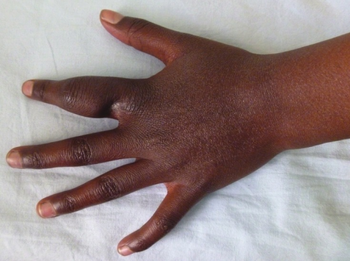Tuberculous dactylitis
| Tuberculous dactylitis | |
|---|---|
 | |
| Fusiform swelling of tubercular dactylitis | |
| Specialty | Infectious disease |
Tuberculous dactylitis is a skeletal manifestation of tuberculosis, one of the commonest bacterial osteitis. It affects children more often than adults.[1] The first radiological description of the condition is credited to Feilchenfeld in 1896; however, the first histological description was given by Rankin in 1886.[2] The Swedish botanist and physician Carl von Linne was the first to mention the condition by the name "spina ventosa" 1746 in his "Västgöta resa".[3]
Multiple bones are involved in children and usually only a single bone is involved in adults suffering from tuberculous dactylitis.[1] Tuberculous dactylitis affects the short tubular bones of the hands and feet in children. It often follows a mild course without fever and acute inflammatory signs as opposed to acute osteomyelitis. There may be a gap of a few months to 2 to 3 years from the time of initial infection to the point of diagnosis.[4][5][6]
Spina ventosa is the term given for tuberculous dactylitis.[7] Nearly 85% of the patients of spina ventosa are below 6 years of age. The bones of hands are more commonly involved than those of the feet. Proximal phalanx of the index and middle fingers are the commonest sites of involvement. Up to nearly 7% of children with pulmonary tuberculosis may develop this condition.[8] Spread to the skeletal system is believed to occur via blood and lymphatics.[9]
Signs and symptoms
In terms of the clinical presentation we find that chronic, painful, progressive swelling of fingers/toes occurs[10]
Pathogenesis
In the pediatric age group, the marrow in the phalangeal bones are still active, a conducive place for the tuberculous bacilli to multiply. Slowly, the whole marrow space gets involved and this underlying granulomatous disease leads to expansion of the overlying soft cortex. Finally there is a fusiform dilation of the bone, with thinned out cortex and destruction of the marrow space leading to a balloon like shape; this cystic type of expansion of the bone is termed as spina ventosa.[11]
Diagnosis
The diagnosis of the condition is made on the basis of histological and bacteriological studies. Tuberculosis dactylitis may be confused with conditions like osteomyelitis, gout, sarcoidosis and tumors.[12][13]
Treatment
The management of Tuberculous dactylitis is done via four drugs isoniazid, rifampicin, pyrazinamide, and ethambutol[10]
References
- ↑ 1.0 1.1 Vuyst, Dimitri De; Vanhoenacker, Filip; Gielen, Jan; Bernaerts, Anja; Schepper, Arthur M. De (2003). "Imaging features of musculoskeletal tuberculosis". European Radiology. 13 (8): 1809–19. doi:10.1007/s00330-002-1609-6. PMID 12942283. S2CID 13465651.
- ↑ Pearlman, H. S.; Warren, R. F. (1961). "Tuberculous dactylitis". American Journal of Surgery. 101 (6): 769–71. doi:10.1016/0002-9610(61)90724-3. PMID 13733764.
- ↑ Linnaeus, Carl (1978). Västgöta resa år 1746. Stockholm: Wahlström & widstrand. p. 131. ISBN 91-46-13190-6.
- ↑ Subasi, M; Bukte, Y; Kapukaya, A; Gurkan, F (2004). "Tuberculosis of the metacarpals and phalanges of the hand". Annals of Plastic Surgery. 53 (5): 469–72. doi:10.1097/01.sap.0000130708.80606.6a. PMID 15502464. S2CID 35203922.
- ↑ Coombs, R; Fitzgerald, FH (1989). Infection in the orthopaedic patient. Great Britain: Butterworth & Co Ltd. pp. 297–8. ISBN 978-0-407-01316-2.
- ↑ Al-Qattan, MM; Bowen, V; Manteo, RT (1994). "Tuberculosis of the hand". Journal of Hand Surgery (Edinburgh, Scotland). 19 (2): 234–7. doi:10.1016/0266-7681(94)90175-9. PMID 8014559. S2CID 39092144.
- ↑ Cremin, B. J.; Jamieson, D. H. (1995). "Imaging of Skeletal Tuberculosis". Childhood Tuberculosis: Modern Imaging and Clinical Concepts. London: Springer-Verla. p. 99. doi:10.1007/978-1-4471-3011-6_6. ISBN 978-1-4471-3013-0. Reviewed in Cant, A. J. (1996). "Childhood Tuberculosis. Modern Imaging and Clinical Concepts". Archives of Disease in Childhood. 75 (4): 359. doi:10.1136/adc.75.4.359-a. PMC 1511729.
- ↑ Salimpour, R.; Salimpour, P. (1997). "Picture of the month. Tuberculous dactylitis". Archives of Pediatrics & Adolescent Medicine. 151 (8): 851–2. doi:10.1001/archpedi.1997.02170450101018. PMID 9265892.
- ↑ Zoga, A; Lee, V. W. (1999). "Paediatric case of the day. Tuberculosis dactylitis and primary pulmonary tuberculosis". American Journal of Roentgenology. 173 (3): 813, 815–7. doi:10.2214/ajr.173.3.10470936. PMID 10470936.
- ↑ 10.0 10.1 Yadav, AK; Ks, A; Mishra, S; Bansal, S; Manna, J; Napit, AR (October 2020). "Tuberculous Dactylitis in Adult - A Case Report and Review of Literature". Journal of orthopaedic case reports. 10 (7): 72–75. doi:10.13107/jocr.2020.v10.i07.1924. PMID 33585321. Archived from the original on 1 February 2023. Retrieved 27 January 2023.
- ↑ Bhaskar; Tashi, Konglah; Bareh, Jerryson (2013). "Tuberculous dactylitis (spina ventosa) with concomitant ipsilateral axillary scrofuloderma in an immunocompetent child: A rare presentation of skeletal tuberculosis". Advanced Biomedical Research. 2 (1): 29. doi:10.4103/2277-9175.107993. PMC 3748632. PMID 23977657.
- ↑ Sunderamoorthy, D; Gupta, V; Bleetman, A (2001). "TB or not TB: an unusual sore finger". Emergency Medicine Journal. 18 (6): 490–1. doi:10.1136/emj.18.6.490. PMC 1725720. PMID 11696511.
- ↑ Jensen, CM; Jensen, CH; Paerregaard, A (1991). "A diagnostic problem in tuberculous dactylitis". Journal of Hand Surgery (Edinburgh, Scotland). 16 (2): 202–3. doi:10.1016/0266-7681(91)90177-P. PMID 2061665. S2CID 10289363.
External links
| Classification |
|---|